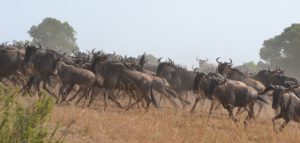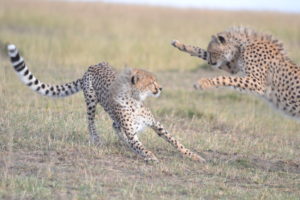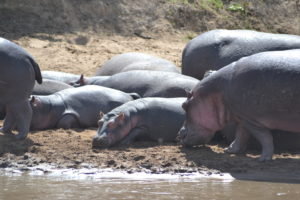A new day, a new destination, and a new means of travel. We were met at the house by Isaac and his van, a vehicle capable of amazing feats, largely as a result of Isaac’s immense driving skills, later becoming referred to as simply ‘the van that could’. Travelling through Nairobi was a tiresome experience, with traffic being characteristically congested, and patience limited. Leaving the bustling streets of Nairobi, and moving into the Rift Valley itself, it became clear that driving in Kenya as a whole, not simply the capital city, would be dissimilar to that of the UK, with possibly only the apparent lack of time displayed by the residents being comparable to that which I am used to living in London. As we speed along expansive highways overlooking the open savanna of the valley, it began to feel as though the journey had truly begun. No longer were we to be within arms distance to the busy streets of Nairobi, enclosed by fences and roads, we would be heading towards more wild, more free lands.
The impact of human settlement remained apparent, with townships being dispersed at regular intervals as the highways sprawled away from the city, notable due to the abundance of hand painted advertisements covering the faces of houses and shops alike. We stopped at the largest town on the route to the Mara, the hectic town of Narok, where we took refreshments in a coffee shop which would not have seemed particularly out of place in the most hipster rich areas of our home country, were it not for the lack of waxed moustaches and wide brimmed glasses.
From Narok Town we travelled the remaining hours on dirt roads, and I should add, with limited suspension, until we made it to our campsite, located only a short jaunt away from the entrance to the Maasai Mara itself. Although leaving slightly later than planned had meant that we arrived at our lodgings in darkness, it did also provide us a brilliant opportunity to view the sun setting as we travelled along newly constructed Chinese roads, with the brilliance coming largely from the visual spectacle provide, and less so due to the new investment of the Chinese government in the area. Collapsing into our beds, we set out to recover from the day of travelling which we had just endured, with an early morning being required if we were to make the most of the wonderful fauna which the Mara had to offer. We slept to the rhythmic grunting of blue wildebeest (Connochaetes taurinus), interspersed by the howling of local spotted hyena (Crocula crocula) clans, and the distant male lions (Panthera leo).
Although we woke at 5:00am, the potential tiredness was apparently overcome in full by the excitement of what was to come. A hearty breakfast, provided by a local hotel, was all that would be required to sustain us, and before long we were packed back into our heroic little van to continue into the park.
Unlike Nairobi National Park the Maasai Mara was not run by the central government, through the Kenyan Wildlife Service, instead being controlled by the local county government, being a national reserve as opposed to a national park. Our visit would allow us to compare the differences between the successes of the different management strategies, viewing the dissimilarities seen on the ground. The scale of the areas also vary greatly, with the Mara being far larger than Nairobi National Park, as well as the regions in which they are found. Nairobi National Park, for example borders Nairobi on three sides, whilst the Maasai Mara borders the Serengeti in Tanzania, an area roughly the size of Wales, with an abundance of fauna, and lack of human activity.
As we drove towards the reserve entrance, only a short trip from our breakfast stop, we met a pair of French travellers who joined us for our journey.*
‘That’s a lot of wildebeest’ is likely a good description of the general sense of the day. The great migration of wildebeest north from the Greater Serengeti ecosystem is truly spectacular. The number of the beasts seen is difficult to comprehend, with literally thousands upon thousands of the creatures being present. Not only were the wildebeest in great abundance, with other bovids such as Grant’s and Thomson’s gazelles (Gazella granti and thomsoni respectively), and common eland (Tragelanhus oryx) being present in herds an order of magnitude larger than those seen in Nairobi.


‘A series of National Geographic highlights’ would also be an apt description of the day, with marvel upon marvel being observed as we travelled through the park. From the rather boisterous cheetah cubs play fighting and their unimpressed looking mother within arm’s reach of our van, to infiltration of Maasai giraffe (Giraffa tippelskirchi) herds, being unmoved by our presence. A live wildebeest river crossing, complete with dust galore; a riverside walk accompanied by huge Nile crocodiles (Crocodylus niloticus) and hippopotamus (Hippopdomas amphibius) pods (as well as an armed guard); a 20 strong spotted hyena clan cooling down in muddy pools after an apparently particularly filling meal.


Lunch, too was both novel and extraordinary, eating the contents of our picnic alongside the bones of what appeared to be a zebra, with a pair of large male African elephants coming within 150 metres of us to investigate what was occurring (a distance which feels much shorter when in relation to animals so large).

The diversity, as well as the abundance, of organisms seen in the Mara was astounding, providing both an unforgettable experience, and a brilliant set point with which other parks and reserves should be compared.
The following day would be spent visiting the Olerai Conservancy, only a short distance from the Mara reserve, where we were given a guided tour by its manager, Saleem Mandela. We had met Saleem the previous evening over dinner, where he gave us an overview of the structuring of the conservancy. At one point he asked ‘Will you be wanting to do a walking or driven safari?’, to which Enoch replied ‘I think that we will decide tomorrow’. ‘My elephants are very fierce’ chuckled Saleem, and we responded with laughter, that was until, with brilliant comedic timing, Saleem stopped us, stating ‘No, seriously, they’ve killed three people in the last week’. We were reassured that neither this, nor the description of the sheep flattened to a pancake-like state recently, should however put us off from visiting. As dedicated students of the University of Cambridge, a small risk of being crushed to death by elephants would not prevent us from being able to learn from Mr Mandela about the management, governance, and history of his conservancy, to gain an insight into the modern approach to conservation in Kenya. We would not, however, be going on any walking safaris.
The tour, this time not in the company of a pair of French tourists, did bring us into close proximity to a young bull elephant in must, but this was from the safety of our trusty van, and with Isaac at the helm it was clear that we were in safe hands. We also observed a multitude of bird species, rock hyraxes (Procavia capensis), and agamas (both Acanthocercus atricollis and Agama mwanzae), previously unseen, as well as many of the giraffes, zebra, and various bovids with which we have become familiar. We finished our tour with a discussion about the conservancy and its future, before returning to our campsite, where we would be able to rest, recovering from a multitude of early starts, bumpy journeys, and very un-English weather.

Excessively long sentences constructed by Andrew Dixon.
*This is likely as confusing to us as it is to you.
